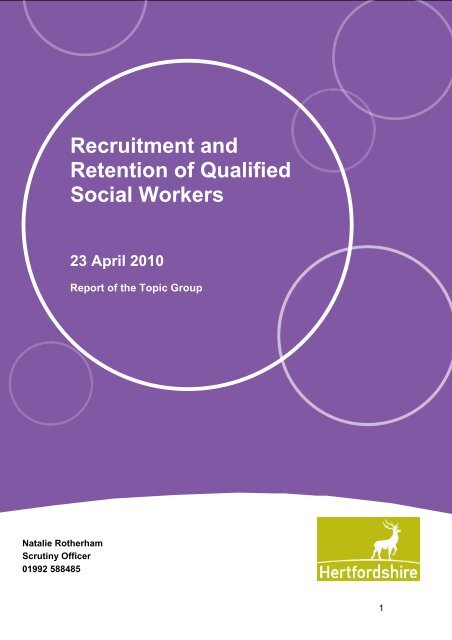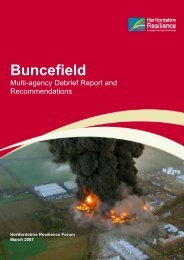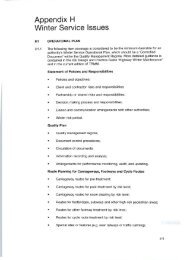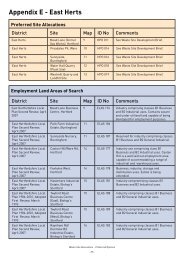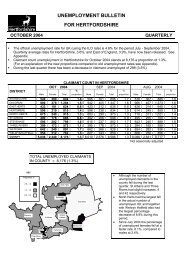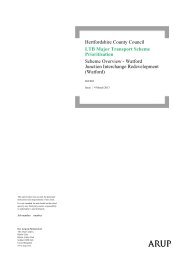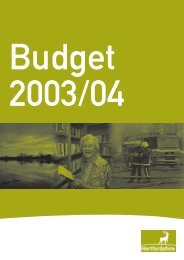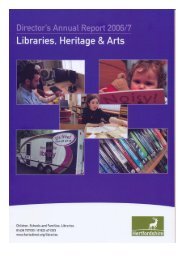Recruitment and Retention of Qualified Social Workers
Recruitment and Retention of Qualified Social Workers
Recruitment and Retention of Qualified Social Workers
You also want an ePaper? Increase the reach of your titles
YUMPU automatically turns print PDFs into web optimized ePapers that Google loves.
<strong>Recruitment</strong> <strong>and</strong><br />
<strong>Retention</strong> <strong>of</strong> <strong>Qualified</strong><br />
<strong>Social</strong> <strong>Workers</strong><br />
23 April 2010<br />
Report <strong>of</strong> the Topic Group<br />
Natalie Rotherham<br />
Scrutiny Officer<br />
01992 588485<br />
1
Contents<br />
1. Purpose <strong>of</strong> Report 3<br />
2. Recommendations 3<br />
3. Background 3<br />
4. Question 1 - What are the current <strong>and</strong> emerging 4<br />
issues for recruitment & retention <strong>of</strong> <strong>Qualified</strong><br />
<strong>Social</strong> <strong>Workers</strong><br />
5. Question 2 - How well do HCC policies <strong>and</strong> 5<br />
practices enable effective recruitment <strong>and</strong> retention<br />
<strong>of</strong> <strong>Qualified</strong> <strong>Social</strong> <strong>Workers</strong><br />
6. Question 3 - What are the priorities <strong>and</strong> planned 6<br />
activities for HCC in continuing to reduce vacancy<br />
levels <strong>of</strong> <strong>Qualified</strong> <strong>Social</strong> <strong>Workers</strong><br />
7. Question 4 What could HCC do to benefit from 8<br />
good practice elsewhere<br />
8. Conclusions 8<br />
9. Members <strong>and</strong> Witnesses 9<br />
Appendix 1 Scoping Document<br />
2
1.0 Purpose <strong>of</strong> Report<br />
1.1 This is the report <strong>of</strong> the <strong>Social</strong> Worker <strong>Recruitment</strong> & <strong>Retention</strong> Topic<br />
Group. Its focus was the effectiveness <strong>of</strong> current processes for the<br />
recruitment <strong>and</strong> retention <strong>of</strong> <strong>Qualified</strong> <strong>Social</strong> <strong>Workers</strong> in Children,<br />
Schools & Families (CSF).<br />
1.2 The scoping document can be seen at Appendix 1. The papers issued<br />
to Members prior to the meeting can be found at:<br />
Papers for the <strong>Recruitment</strong> <strong>and</strong> <strong>Retention</strong> <strong>of</strong> <strong>Qualified</strong> <strong>Social</strong> <strong>Workers</strong><br />
Topic Group<br />
1.3 It should be noted that the report covers CSF assessment, locality <strong>and</strong><br />
children looked after teams only, other teams were outside the scope <strong>of</strong><br />
this scrutiny.<br />
2.0 Recommendations<br />
2.1 Consideration be given to developing a business case to increase the<br />
numbers joining the Academy during 2010/11 on the spend to save<br />
principle (See paragraph 6.5)<br />
2.2 Hertfordshire County Council (HCC) explores ways <strong>of</strong> encouraging staff<br />
in related fields to become social workers (See paragraph 6.4)<br />
2.3 A communications strategy is developed to highlight the positive<br />
outcomes <strong>of</strong> the work undertaken by social workers in the child<br />
protection field (See paragraphs 3.1, 5.5, 8.7)<br />
2.4 HCC develops appropriate means <strong>of</strong> recognising when exceptional work<br />
has been undertaken by social workers (See paragraphs 5.5)<br />
2.5 Current employee incentives are reviewed to focus more clearly on the<br />
areas <strong>of</strong> most difficult recruitment (See paragraphs 5.4, 5.5)<br />
2.6 IT support is reviewed to become more responsive to the needs <strong>of</strong> social<br />
workers (See paragraph 4.2, 8.3)<br />
2.7 CSF widens the channels used to gain staff views (See paragraph 4.1)<br />
3.0 Background<br />
3.1 <strong>Qualified</strong> Children & Families <strong>Social</strong> Worker recruitment <strong>and</strong> retention is<br />
a national problem. <strong>Recruitment</strong> <strong>and</strong> retention has been further<br />
compounded by the adverse publicity generated by the Baby Peter<br />
tragedy. <strong>Social</strong> worker case loads have also increased with a rise in the<br />
number <strong>of</strong> referrals.<br />
3
3.2 Key data for Hertfordshire Child Protection teams<br />
3.3<br />
2010 April October<br />
Establishment 187 187<br />
In post 126 154<br />
Vacancy 59 33<br />
Agency cover 49 33<br />
Academy in post 27 30<br />
3.4 Hertfordshire’s proximity to London, where salaries are higher, affects<br />
recruitment/retention rates. The target caseload for a <strong>Qualified</strong> <strong>Social</strong><br />
Worker (QSW) in a Locality Team is 12 – 15 cases. The current average<br />
caseload in Hertfordshire is up to 20 cases, <strong>and</strong> in some instances (for<br />
example where there is more than one child within a family who requires<br />
a QSW) the caseload can be higher. Turnover in Assessment Teams is<br />
higher: here the target caseload is 20 – 25 cases, but actual caseload<br />
has at times been as high as 40 – 50 in Hertfordshire. Lord Laming<br />
recommended a caseload <strong>of</strong> no more than 20 cases for an assessment<br />
QSW <strong>and</strong> 10 – 12 for a locality QSW. On average three social workers<br />
per month leave the authority.<br />
3.5 Poor inspection results can lead to associated reputational risk. The<br />
latter can increase the recruitment problem, as good social workers are<br />
unlikely to want to work for an authority with a poor reputation.<br />
4.0 What are the current <strong>and</strong> emerging issues for recruitment &<br />
retention <strong>of</strong> <strong>Qualified</strong> <strong>Social</strong> <strong>Workers</strong><br />
4.1 Exit interviews <strong>and</strong> focus groups with current staff have been used to<br />
establish what the issues are leading to staff departure. Workload,<br />
management support, excessive hours, stress management <strong>and</strong> career<br />
progression have all been highlighted. There is an issue with the focus<br />
groups as attendance could be improved. It does not hear from people<br />
with time pressures or who do not prioritise it, for whatever reason. The<br />
Group believe it is important to improve hearing the views <strong>of</strong> a crosssection<br />
<strong>of</strong> staff <strong>and</strong> would like CSF to consider ways <strong>of</strong> engaging with all<br />
staff.<br />
4.2 <strong>Social</strong> workers use the Integrated Children System (ICS). Ofsted<br />
regarded its implementation as a strength; however QSWs view ICS as<br />
not being user friendly, extremely laborious <strong>and</strong> very repetitive. CSF has<br />
invested heavily in Superusers to assist staff. Superusers have provided<br />
invaluable support; with current financial pressures the future funding for<br />
Superusers is uncertain.<br />
4
4.3 It is costly to employ people who subsequently have to go through<br />
disciplinary procedures, or take extensive sick leave. Ensuring that job<br />
descriptions accurately reflect the requirements <strong>of</strong> the role, <strong>and</strong> trying to<br />
assess the resilience <strong>of</strong> applicants at the interview stage can prevent<br />
later problems.<br />
5.0 How well do HCC policies <strong>and</strong> practices enable effective<br />
recruitment <strong>and</strong> retention <strong>of</strong> <strong>Qualified</strong> <strong>Social</strong> <strong>Workers</strong><br />
5.1 Recent changes are improving services, reducing caseloads <strong>and</strong><br />
improving the reputation <strong>of</strong> the authority as a place to work, but these<br />
changes will take time to filter through. A long-term approach rather than<br />
a ‘quick fix’ is needed.<br />
5.2 A number <strong>of</strong> incentives have been introduced to attract social workers,<br />
such as a generous annual leave allowance, lease car, flexible working,<br />
employee assistance scheme, pension scheme, relocation allowance up<br />
to £6,000<br />
5.3 The Group heard from a permanent social worker who had originally<br />
joined the authority as a temp. In her view the benefits <strong>of</strong> working for<br />
Hertfordshire included<br />
• the lease car system<br />
• Hertfordshire is a safe place to work in terms <strong>of</strong> practice<br />
• there is a good ‘gatekeeping’ system <strong>of</strong> screening referrals <strong>and</strong><br />
being able to act in a timely fashion<br />
• the working environment is good<br />
• laptops are provided <strong>and</strong> there is always a work area available<br />
• flexible working hours <strong>and</strong> working from home are good<br />
• ICS (Integrated Children System) is ‘brilliant’ <strong>and</strong> gives good<br />
accountability<br />
• the market forces payment<br />
• her manager has an ‘open door’ policy <strong>and</strong> there is always<br />
someone to go to for advice.<br />
5.4 The market forces payment has been used to overcome pay issues, but<br />
its effectiveness has been ‘watered down’ as workers in some teams<br />
which do not have recruitment issues have also received this payment.<br />
The Group felt that there needs to be appropriate targeting <strong>of</strong> rewards<br />
e.g. staff who take extensive sick leave currently still receive the market<br />
forces payment.<br />
5.5 The welcome payment, moreover, requires a balance between<br />
encouraging new people but not de-motivating existing loyal staff.<br />
Members felt that more could be done to recognise excellent<br />
performance. Whilst there is a compliments system, recognition via CSF<br />
news <strong>and</strong> thanks from individual managers, at times the best workers<br />
have the most difficult cases <strong>and</strong> so do not receive due<br />
5
acknowledgement. Small rewards such as vouchers could be an<br />
effective way <strong>of</strong> creating pride <strong>and</strong> loyalty.<br />
6.0 What are the priorities <strong>and</strong> planned activities for HCC in continuing<br />
to reduce vacancy levels <strong>of</strong> <strong>Qualified</strong> <strong>Social</strong> <strong>Workers</strong><br />
6.1 The Group was pleased to hear that Hertfordshire is well ahead <strong>of</strong> other<br />
authorities in its <strong>of</strong>fer to newly qualified social workers. There is a 12-<br />
week ‘Return to <strong>Social</strong> Work’ programme, endorsed by the University <strong>of</strong><br />
East London, to encourage social workers to return to the pr<strong>of</strong>ession,<br />
<strong>and</strong> consideration is being given nationally to a bursary scheme.<br />
6.2 A key element <strong>of</strong> recruiting <strong>and</strong> retaining strategy is the Academy,<br />
launched October 2009. The Academy <strong>of</strong>fers a 12-month training<br />
programme covering key areas such as the legal framework,<br />
safeguarding children, common assessment framework <strong>and</strong> personal<br />
safety training, for newly-qualified social workers. It is being monitored<br />
by the Children’s Workforce Development Council (CWDC).<br />
6.3 The Group heard from a newly qualified social worker who participated in<br />
the first wave. She joined Hertfordshire because <strong>of</strong> its<br />
• reputation<br />
• the fact that career progression was mentioned at interview stage<br />
• enjoys the work, has a good variety <strong>of</strong> work reflecting a broad range<br />
• feels that the training <strong>and</strong> support <strong>of</strong> the Academy is excellent <strong>and</strong><br />
that it was good to have the support <strong>of</strong> the Academy rather than<br />
going straight into a frontline team<br />
• benefits such as the lease car <strong>and</strong> market forces payment are very<br />
good<br />
• feels that HCC looks after staff.<br />
6.4 A previous topic group had focused on Police Community Support<br />
Officers (PCSOs). Members were concerned that in spite <strong>of</strong> the high<br />
level <strong>of</strong> social care work undertaken by PCSOs, it does not appear that<br />
PCSOs with an interest in this area are able to develop a career in social<br />
care. The PCSO Topic Group wanted to see the development <strong>of</strong> career<br />
pathways among partners e.g. access to working in social care. One <strong>of</strong><br />
the Group’s recommendations was that potential career opportunities for<br />
PCSOs are identified by the funding partners in order to retain the<br />
investment <strong>and</strong> skills/knowledge made. The point was made at this<br />
scrutiny that Teaching Assistants <strong>and</strong> Family Support <strong>Workers</strong> have<br />
developed a wide range <strong>of</strong> appropriate skills <strong>and</strong> familiarity with the<br />
pressures <strong>of</strong> this work which could assist in the recruitment <strong>of</strong> the right<br />
staff. The Group are aware that encouraging people who have good<br />
unqualified experience into the pr<strong>of</strong>ession needs to be a balanced with<br />
the cost associated with supporting them.<br />
6
6.5 There would be benefit in considering ways <strong>of</strong> bringing into the authority<br />
those people who cannot get into the Academy due to lack <strong>of</strong> places.<br />
Exp<strong>and</strong>ing the Academy would require additional resources as it is<br />
currently funded from the existing staffing budget. The Group were<br />
interested in the spend to save argument to address current <strong>and</strong> future<br />
staffing pressures.<br />
6.6 The focus for Academy is training <strong>and</strong> supporting newly qualified social<br />
workers. The Academy is addressing the need to build the workforce <strong>of</strong><br />
the future; however this does not tackle the loss <strong>of</strong> experienced staff.<br />
CSF, along with many authorities, has significant vacancies for<br />
experienced social workers. There is scope to develop the role <strong>of</strong> the<br />
Academy, this needs to be balanced with the recruitment <strong>of</strong> experienced<br />
staff to provide depth <strong>of</strong> experience in teams. The service needs<br />
experienced staff in order to allocate complex work <strong>and</strong> manage teams.<br />
In the past Agency staff have traditionally been used as a temporary<br />
measure; however, in a c<strong>and</strong>idates market costs are raising <strong>and</strong> the cost<br />
ratio is currently 1.7 agency staff to 3 permanent staff. In addition there<br />
can be consistency <strong>and</strong> management issues with agency workers.<br />
6.7 To tackle these problems an overseas recruitment was undertaken.<br />
Drawing on previous HCC experience <strong>and</strong> that <strong>of</strong> other authorities<br />
careful consideration was given to matching CSF’s requirements.<br />
Canada was chosen as the language, legislation, background culture<br />
<strong>and</strong> qualifications are the most similar to UK requirements. C<strong>and</strong>idates<br />
were screened by Children’s Service Managers from HCC in Canada.<br />
The authority also set up a micro site to inform c<strong>and</strong>idates about<br />
Hertfordshire. C<strong>and</strong>idates were fully advised about terms <strong>and</strong> conditions<br />
before they signed up. To assist the new cohort in settling in a new<br />
induction programme was set up for the new cohort. A 12% charge<br />
against starting salary was charged by the agency; however, members<br />
were reassured to hear that the Canadian recruitment resulted in a<br />
significant saving overall.<br />
6.8 The Group heard from an experienced social worker who joined CSF<br />
from Canada. Her decision to move to Hertfordshire was based on<br />
• proximity <strong>of</strong> Hertfordshire to London<br />
• the relocation package<br />
• educational opportunities<br />
• faster career progression than available to agency workers<br />
• difficulty <strong>of</strong> starting over at another authority having built a<br />
pr<strong>of</strong>essional reputation in Hertfordshire.<br />
The last point is interesting as there is substantial evidence that<br />
experienced social workers do not move authorities, except to move<br />
house or for promotion. She thought the Academy was a positive<br />
development, especially as she had concerns for Newly <strong>Qualified</strong> <strong>Social</strong><br />
7
<strong>Workers</strong> (NQSWs) <strong>and</strong> how they develop pr<strong>of</strong>essionally if joining teams<br />
immediately on appointment.<br />
6.9 Whilst it is too early for a full analysis no adverse comments have been<br />
received <strong>and</strong> the Group were pleased to hear that two further recruitment<br />
waves are planned.<br />
7.0 What could HCC do to benefit from good practice elsewhere<br />
7.1 The Group heard from HR Officers from Surrey County Council which<br />
has faced similar issues to Hertfordshire (proximity to London, ageing<br />
work force etc). In response to an ‘inadequate’ JAR (Joint Area Review)<br />
in April 2008 a social work recruitment taskforce was set up. A benefit is<br />
that the problem <strong>of</strong> social worker shortage gained an organisational<br />
focus. Short term actions have led to improving processes which have<br />
resulted in a reduction in the vacancy rate <strong>and</strong> number <strong>of</strong> locum staff.<br />
The total number <strong>of</strong> posts has also been reduced. In contrast to HCC<br />
attempts at overseas recruitment were unsuccessful.<br />
7.2 Medium term actions have included raising salary; improving links to<br />
universities, improving social work student placements <strong>and</strong> recruitment;<br />
engaging with the CWDC in a return to social work scheme; a fast track<br />
graduate scheme; a NQSW support scheme; <strong>and</strong> a service restructure.<br />
7.3 Longer term actions include lobbying for better workforce planning.<br />
8.0 Conclusions<br />
8.1 The Group recognise that the recruitment/retention strategy is a 2-3 year<br />
plan. Members endorse the long term approach to resolve<br />
recruitment/retention issues as opposed to short term quick fixes. There<br />
is someway to go but significant progress has been made due the efforts<br />
<strong>of</strong> the HR <strong>and</strong> CSF teams involved.<br />
8.2 The Group were interested to hear from Surrey County Council. It<br />
confirmed that recruitment/retention issues are common across the<br />
southeast. On reflection members felt that the approaches undertaken<br />
by HCC are well thought through solutions to address the long term<br />
needs <strong>of</strong> the organisation.<br />
8.3 ICS is valued by social workers; however it is complex to use. This is an<br />
area where effective IT support would remove some <strong>of</strong> the work related<br />
stress experienced by social workers. Permanent Superusers <strong>and</strong>/or<br />
changes to the contracts with Serco <strong>and</strong> Liquidlogic would be a<br />
significant benefit<br />
8.4 It is imperative that strategies adopted seek to develop the workforce for<br />
the future in managing the balance <strong>of</strong> NQSWs <strong>and</strong> experienced social<br />
workers <strong>and</strong> team managers.<br />
8
8.5 The reputation <strong>of</strong> an authority has an impact on recruitment/retention.<br />
Existing <strong>and</strong> prospective employees consider the Ofsted inspection<br />
rating <strong>and</strong> the support <strong>and</strong> training <strong>of</strong>fered to staff. The Group were<br />
reassured to hear that staff are positive about working for HCC.<br />
8.6 Good management is key - social workers stay in teams where<br />
management is effective. Being a good social worker <strong>and</strong> being a good<br />
manager are different skillsets; new managers need effective support<br />
<strong>and</strong> training.<br />
8.7 <strong>Social</strong> work with children is frequently subject to negative publicity. This<br />
has impact on the numbers <strong>of</strong> people becoming social workers <strong>and</strong> then<br />
remaining in this area. After hearing from witnesses, especially frontline<br />
social workers, the Group concluded that a positive publicity campaign<br />
(locally <strong>and</strong> nationally) to counter the prevailing critical reporting would<br />
highlight the vital work Hertfordshire social workers undertake.<br />
9 Members <strong>and</strong> Witnesses<br />
Members:<br />
Maxine Crawley<br />
Aislinn Lee (Vice-Chairman)<br />
Chris Mitchell<br />
Le<strong>and</strong>a Newlyn (Chairman)<br />
Steven Markiewicz<br />
Other Members in attendance:<br />
Alan Searing, Chairman <strong>of</strong> the Overview <strong>and</strong> Scrutiny Committee<br />
Witnesses:<br />
Emily Boynton, Human Resources Relationship Manager, Surrey County<br />
Council<br />
Lariena Carroll, HR Officer<br />
Paul Chamberlain, Lead HR Business Partner<br />
Lisa Christie, <strong>Qualified</strong> <strong>Social</strong> Worker, CSF<br />
Nicola Curley, Children’s Service Manager, CSF<br />
Tina Darko, Assistant Team Manager, Assessment West 2<br />
Robin Duncan, Advanced Practitioner, CSF<br />
R Hall, HR Business Partner – Resourcing<br />
Angela Hodson, Safestaffing Manager<br />
Jan Kavanagh, Human Resources Manager<br />
Gerry Meikle, UK Operations Manager, Manpower<br />
Steve Morris, Children’s Service Manager, CSF<br />
Lucy Mustoe, <strong>Recruitment</strong> Team Leader, Surrey County Council<br />
Louise Purser, Head <strong>of</strong> CSF <strong>Social</strong> Care Learning <strong>and</strong> Development<br />
Jan Stone, Client Relationship Manager, Manpower<br />
9
Louise Tibbert, Head <strong>of</strong> Human Resources <strong>and</strong> Organisational<br />
Development<br />
Alison Twynam, Head <strong>of</strong> Policy, Practice <strong>and</strong> Quality Assurance, CSF<br />
Officers:<br />
Emma Lund, Democratic Services Officer<br />
Natalie Rotherham, Scrutiny Officer<br />
10
Appendix 1<br />
SCRUTINY REMIT:<br />
SCRUTINY SCOPING DOCUMENT:<br />
<strong>Recruitment</strong> <strong>and</strong> <strong>Retention</strong> <strong>of</strong> <strong>Qualified</strong> <strong>Social</strong> <strong>Workers</strong><br />
OBJECTIVE:<br />
To scrutinise the effectiveness <strong>of</strong> recruitment <strong>and</strong> retention <strong>of</strong> <strong>Qualified</strong> <strong>Social</strong><br />
<strong>Workers</strong> in Children, Schools & Families.<br />
QUESTIONS TO BE ADDRESSED:<br />
1. What are the current <strong>and</strong> emerging issues for recruitment & retention <strong>of</strong><br />
<strong>Qualified</strong> <strong>Social</strong> <strong>Workers</strong><br />
2. How well do HCC policies <strong>and</strong> practices enable effective recruitment <strong>and</strong><br />
retention <strong>of</strong> <strong>Qualified</strong> <strong>Social</strong> <strong>Workers</strong><br />
3. What are the priorities <strong>and</strong> planned activities for HCC in continuing to<br />
reduce vacancy levels <strong>of</strong> <strong>Qualified</strong> <strong>Social</strong> <strong>Workers</strong><br />
4. What could HCC do to benefit from good practice elsewhere<br />
OUTCOME:<br />
1. The reasons for the current levels <strong>of</strong> vacancies <strong>and</strong> turnover in the<br />
workforce are better understood.<br />
2. Clear strategies are identified to drive down vacancy levels <strong>and</strong> associated<br />
costs.<br />
3. Policies <strong>and</strong> practices are fit for purpose <strong>and</strong> enable line managers to<br />
manage vacancy levels effectively within their teams.<br />
CONSTRAINTS:<br />
Only covers CSF assessment, locality <strong>and</strong> children looked after.<br />
METHOD: one <strong>of</strong>f (1 day) DATE: 23 April 2010<br />
MEMBERSHIP: Maxine Crawley, Aislinn Lee (Vice-Chairman), Chris Mitchell,<br />
Le<strong>and</strong>a Newlyn (Chairman), Steven Markiewicz<br />
EVIDENCE & WITNESSES:<br />
• CSF Inspection <strong>and</strong> implications for childcare budget, Sue Williams<br />
• <strong>Recruitment</strong> <strong>and</strong> <strong>Retention</strong> Data, Paul Chamberlain<br />
• Hertfordshire Academy for Newly <strong>Qualified</strong> <strong>Social</strong> <strong>Workers</strong>, Steve Morris<br />
• Comparative good practice with other Local Authorities, TBC<br />
• Manpower – an external perspective, Gerry Meikle<br />
• SW Taskforce – implications for HCC, Louise Purser<br />
• Recruiting from overseas, Phillip Poole<br />
• <strong>Social</strong> <strong>Workers</strong> – story from the frontline<br />
11
1. Grow your own TBC<br />
2. Recent recruit TBC<br />
3. Temp to perm TBC<br />
4. International success TBC<br />
• Financial implications <strong>and</strong> restraints, Debbie Pettit<br />
SUPPORT:<br />
Scrutiny Officer: Natalie Rotherham<br />
Lead Officers: Louise Tibbert, Paul Chamberlain<br />
Democratic Services Officer: Emma Lund<br />
HCC CORPORATE PRIORITIES : how this item helps deliver these priorities<br />
1.Support economic well being<br />
Children are supported to achieve their potential <strong>and</strong> become<br />
economically active citizens<br />
2. Maximise independent living<br />
Children are enabled to develop resilience <strong>and</strong> to live independently<br />
3. Ensure a positive childhood<br />
Children are living in secure homes where they feel safe <strong>and</strong> protected<br />
4. Secure a good education for all<br />
Children are supported to develop good attendance <strong>and</strong> achieve to the<br />
best <strong>of</strong> their ability<br />
5. Reduce carbon emissions<br />
There is no direct contribution to this priority<br />
6. Promote safe neighbourhoods<br />
There is no direct contribution to this priority<br />
7. Be a leading council<br />
Improve KPIs on initial <strong>and</strong> core assessments to timescale<br />
CfPS OBJECTIVES:- how the item delivers these objectives<br />
1. Provides a critical friend challenge to executive policy makers <strong>and</strong><br />
decision makers<br />
2. Enables the voice <strong>and</strong> concerns <strong>of</strong> the public to be heard<br />
3. Is carried out by independent governors who lead <strong>and</strong> own the scrutiny<br />
role<br />
4. Drives improvement in public services<br />
A scrutiny framework described above should meet all these objectives.<br />
12
For further information about this report please contact:<br />
Natalie Rotherham<br />
Scrutiny Officer<br />
Room 322,<br />
County Hall,<br />
Hertford,<br />
SG13 8DQ<br />
Tel: 01992 588485<br />
Scrutiny<br />
01992 588485<br />
www.hertsdirect.org<br />
13


